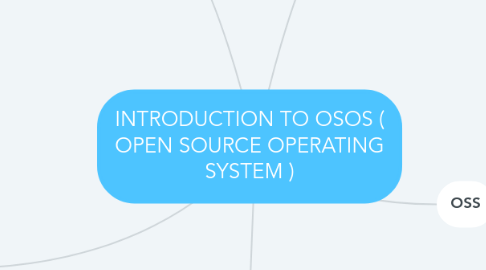
1. LINUX
1.1. History
1.1.1. Created in the early 1990s by finish software engineer Linus Tolvalds
1.2. Boot Loader
1.2.1. Linux Loader ( LILO )
1.2.2. Loadlin ( Load Linux )
1.3. Desktop Environment Windows Manager
1.3.1. WM
1.3.1.1. Dynamic Windows Manager
1.3.1.2. Stacking Windows Manager
1.3.1.3. Compositing Windows Manager
1.3.2. DE
1.3.2.1. Types Of DE
1.3.2.1.1. KDE
1.3.2.1.2. GNOME
1.3.2.1.3. LXDE
1.3.2.2. Main Component
1.3.2.2.1. Desktop
1.3.2.2.2. Windows
1.3.2.2.3. Menus
2. OSS APPLICATION
2.1. Presentation
2.1.1. Pinpoint
2.1.2. Impressive
2.2. Database
2.2.1. Yard SQL
2.2.2. Empress
2.3. Email
2.3.1. Zimbra
2.3.2. Eudora
2.4. Graphics
2.4.1. GIMP
2.4.2. Inkscape
2.5. Animation
2.5.1. VariCAD
2.5.2. Teplot 7.0
3. LICENSES
3.1. LGPL License
3.2. Mozilla License
3.3. MIT License
3.4. BSD License
3.5. GPL License
3.6. Apache License
4. OSS VS CSS
4.1. Open Source Software
4.1.1. Free to use
4.1.2. Customizable
4.1.3. Stable
4.2. Close Source Software
4.2.1. Paid
4.2.2. Fixed
4.2.3. Secure
5. OSS
5.1. Foundation
5.1.1. FSF
5.1.1.1. Free Software Foundation
5.1.1.1.1. Founded on 1985
5.1.2. OSI
5.1.2.1. Open Society Foundation
5.1.2.1.1. Founded on 1993
5.2. Freedom
5.2.1. Download
5.2.1.1. Free download available for third parties
5.2.2. Use
5.2.2.1. Free to use
5.2.3. Amend
5.2.3.1. Modify ourself with own creation
5.2.4. Redistribute
5.2.4.1. The Freedom to distribute copies of your modified version to others
5.3. Advantages / Benefit
5.3.1. Increase customization
5.3.2. Easy integration
5.3.3. Highly secure
5.4. Limitation
5.4.1. Hard to learn
5.4.2. Many of latest hardware incompatible to the open source platform
5.4.3. Need a trained person to handle this easier
5.4.4. Not straightforward to use, little bit complicated
